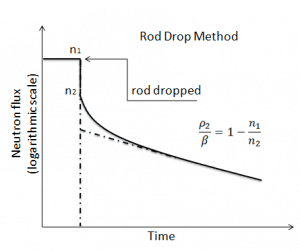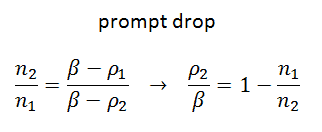 The rod drop method belongs to a group of reactivity perturbation methods. This method is based on the study of the transient response of the reactor to a rapid insertion of high negative reactivity. This rapid reactivity insertion is usually performed by dropping the reactor control rods when the reactor is in a critical state. In this case, the reactivity inserted can be determined from the measurement of the prompt drop.
The rod drop method belongs to a group of reactivity perturbation methods. This method is based on the study of the transient response of the reactor to a rapid insertion of high negative reactivity. This rapid reactivity insertion is usually performed by dropping the reactor control rods when the reactor is in a critical state. In this case, the reactivity inserted can be determined from the measurement of the prompt drop.
As was described in the Prompt Jump Approximation, the response of a neutron detector (n1 ➝ n2) immediately after a control rod is dropped into a critical reactor (ρ1 = 0) is related by:
which allows the determination of the reactivity worth of the rod. The rod drop method is advantageous because it is very quick to perform and requires no extra equipment. Moreover, it can easily and safely measure large amounts of reactivity. On the other hand, the rod drop method is usually associated with reactor shutdown and subsequent reactor startup. Also, the rod drop time is not instantaneous as is theoretically assumed, therefore limiting the method’s accuracy. In PWRs, the drop time of all control rods is usually about 2 – 4 seconds.
This method is widely used to determine the worth of all control rods (i.e., of an emergency shutdown system). This method can also be used to determine the parameters of delayed neutrons, and these data can be obtained by decomposition of neutron flux coastdown.
A more accurate method is, for example, in:
Moore, K. V. Shutdown Reactivity by the Modified Rod Drop Method, USAEC Report ID0-16948, 1964.
